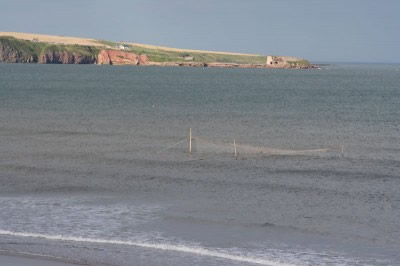These bulletin blogs represent news about Finavon and the South Esk, and my views as a riparian owner. They are not the views of any other organisation, nor are they designed to promote the interests of any individual or organisation other than Finavon Castle Water and factors affecting the fishery. Tony Andrews
It can hardly be a coincidence that, 24 hours after the Usan nets were laid off at the end of the 2011 netting season, fresh grilse began appearing in FCW pools. All four grilse caught in the first two days of the month have been split fresh with sealice. The other good thing about these fish is that all of them have been in good condition, not thin and strap-like, as in the last few years. But that could be because they entered the river late in the summer, enabling them to spend the daylight-filled summer months feeding and building up their body weight.
Those of us who are involved in efforts to put an end to mixed stocks netting (mixed stocks netting = killing fish in the sea from more than one river of origin) have come to realise that the situation in Scotland is different from anywhere else. This is partly because, in the case of the Usan nets owned by the Pullar family, their right to fish is a heritable one. While nearly everyone agrees that mixed stocks netting should end, the Government is between a rock and a hard place, with wild salmon conservationists telling him that mixed stocks netting is bad practice because it kills fish indiscriminately, regardless of whether they are from healthy or fragile populations. On the other side of the argument are the netsmen who present themselves as the artisanal working men of the coast, plying their trade as their ancestors did. A political conundrum if ever there was one!
The photograph above shows an Usan fishery net in the middle of the beach at Lunan Bay. Salmon returning to the North and South Esks tend to sweep round in a gyre heading south before swimming back in a northerly direction close to the shore and into the meshes of Usan nets. These bag nets are located close inshore between the Bay and Scurdie Ness where there are 3 or 4 highly effective netting stations such as Boddin Point and Black Craig, where large numbers of salmon and grilse are captured and killed.
On the East coast of Scotland the mixed stocks situation is especially complex because of the long season and exploitation of stocks from different rivers with their genetically distinct populations, defined by run times or tributaries of origin. If you throw into the argument such factors as the possibility of Greenland resuming a commercial harvest, 70%+ catch and release by anglers versus 100% lethal exploitation by nets, and the common justice element of giving angling proprietors unfair commercial advantage, you have a cocktail of conflicting demands that Solomon himself would have trouble in adjudicating!
The issue is between the human rights of the netting owners versus the conservation needs of the fish in their full genetic diversity. That, in very basic terms, is what all the fuss is about.
However, at least for the rest of the 2011 season, we don’t have to worry about coastal nets because salmon, grilse and late running sea trout can all enter the South Esk unhindered. With some additional water there should be fish to catch, and I am confident that well over 70% of the fish that are caught will be returned alive to the river to continue their journey upstream to spawn. Tight lines!
